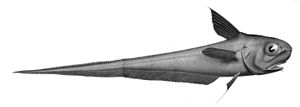Round-nose grenadier
| Round-nose grenadier | ||||||||||||
|---|---|---|---|---|---|---|---|---|---|---|---|---|

Round-nosed grenadier ( Coryphaenoides rupestris ) |
||||||||||||
| Systematics | ||||||||||||
|
||||||||||||
| Scientific name | ||||||||||||
| Coryphaenoides rupestris | ||||||||||||
| Gunnerus , 1765 |
The round-nosed grenadier ( Coryphaenoides rupestris ) is a marine fish from the cool northern Atlantic. Its distribution area extends from the coast of Norway , south to the Biscay and across Iceland and the south of Greenland to Baffin Island and Newfoundland .
features
Like all grenadier fish, the round-nosed grenadier has an elongated body that tapers more and more from front to back and ends in a tip without a tail. The actual trunk ( abdomen ) is short, the tail makes up most of the length of the body. The round-nose grenadier is a maximum of 1.10 meters long, with a maximum weight of 1.69 kg. Usually it stays at a length of 80 to 90 centimeters. The front part of the broad head is rounded and completely scaled. There is a small barb at the tip of the lower jaw . The small, conical teeth on the premaxillary are arranged in three rows, which unite into one at the front. The teeth of the outer row are slightly enlarged. There are one or two irregular rows of teeth on the lower jaw.
The fish are brown to gray in color, fins, mouth and gill areas are blackish to dark gray-brown. At the beginning of the first dorsal fin sits a powerful spiked ray that is sawn on its front. Eight to eleven soft rays follow. The second dorsal fin is less high than the anal fin. The attachment of the second dorsal fin is far behind that of the anal fin. The throaty ventral fins have 7 to 8 fin rays, of which the outer ones are elongated and reach about the length of the head. Round-nose grenadiers have up to 31 long, thin pyloric tubes bent back . The maximum determined age is 54 years.
Way of life
The round-nosed grenadier lives bathypelagically at depths of 180 to 2600 meters, most often between 400 and 1200 meters. It feeds on fish and invertebrates, especially pelagic crustaceans such as shrimp , amphipods and cumacea . He also eats cephalopods . Among the fish, the lantern fish are the most important part of its diet.
Reproduction
The fish spawn in summer, south of Iceland and the Faroe Islands, in July and August at depths of 600 to 1200 meters. A female can lay 12,000 to 35,000 eggs, but only spawns every other year. Males mate annually. The eggs have a diameter of 2.6 mm and drift pelagically at greater depths. At a water temperature of 3.5 to 5 ° C, the larvae hatch in autumn, after 2 to 3 months. They feed mainly on copepods of the genus Calanus , which migrate into deeper water at this time. The fry grow slowly. Males become sexually mature with 40 cm, females with a length of 60 cm.
use
Round-nosed grenadiers are caught with bottom and swim trawls during the summer when they gather in schools to spawn. They are considered overfished.
literature
- Bent J. Muus, Jørgen G. Nielsen: The marine fish of Europe in the North Sea, Baltic Sea and Atlantic. Kosmos, Stuttgart 1999, ISBN 3-440-07804-3 .